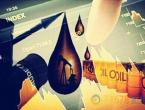Crude oil trading reminder: the rising tone continues! The derivatives market fluctuates sharply, and the oil price outlook looks to the 90 mark
During the Asian session on Tuesday (October 12), U.S. crude oil fell slightly. Oil prices continued their upward trend for several weeks on Monday and rose strongly. U.S. oil once rose to US$82.18/barrel, the highest since the end of 2014; with the increase in economic activity With major oil-producing countries restricting supply, the energy crisis that has plagued major economies shows no signs of alleviation. Coal and natural gas prices are also soaring, making oil more attractive as a fuel for power generation, and driving the oil market higher.
In the day, we will focus on the vacancy of JOLTs in the United States in August, the U.S. House of Representatives vote on the temporary debt ceiling increase bill, and the Federal Reserve Vice Chairman Clarida's speech; in addition, due to Columbus Day in the United States, the API data originally released at 4:30 on Wednesday was postponed to Thursday. Announced at 4:30.
Bullish factors affecting oil prices
[Energy crisis boosts demand, oil prices rise in bullish sentiment]
U.S. crude oil futures closed above US$80 per barrel for the first time since the end of 2014. The increasingly severe power crisis from Europe to Asia boosted oil demand before the winter.
US crude oil futures rose 1.5% on Monday, and Brent crude oil futures were close to $85 per barrel. Winter is approaching in the northern hemisphere, and global coal and natural gas inventories have soared prices, prompting some companies to switch to petroleum products such as diesel and fuel oil.
Fiona Cincotta, a senior financial market analyst at City Index, said that the market must be worried about supply depletion. Even if the Organization of the Petroleum Exporting Countries (OPEC) increases market supply back, "it may not have a huge restraint on oil prices. The oil price of $90 is clearly imminent." "
As the energy crisis intensified, crude oil futures have risen about 20% since mid-August. Saudi Aramco estimates that the shortage of natural gas has increased oil demand by approximately 500,000 barrels per day, and Citigroup estimates that it may reach 1 million barrels per day.
Daniel Yergin, vice chairman of IHS Markit, said that if oil prices continue to rise, the United States may urge OPEC to increase production to ease oil prices. In the past few months, the White House has been communicating this with OPEC.
Although supply and demand factors mean that the crude oil market still has room to rise, it will not last forever. Raymond James & Associates Inc. analyst Pavel Molchanov said that oil prices will eventually hit the "pain threshold", that is, the moment when high oil prices seriously affect demand and the global economic recovery. "OPEC's response and demand-related pain thresholds combined will make oil prices peak. ."
Matt Smith, chief oil analyst at Kpler, said that when demand seems to be picking up sharply, everything is focused on the problem of insufficient supply recovery. Considering that the global natural gas price is so high, there are additional factors in the potential of fuel conversion, so this is a combination of a series of factors that continue to push oil prices up.
[U.S. crude oil derivatives market fluctuates sharply]
The large fluctuations in the prices of petroleum derivatives indicate that the supply of crude oil in the United States is tightening, and the volatility that has plagued the energy market has further intensified.
The spread between the West Texas Intermediate (WTI) futures contract for immediate delivery and the contract for delivery a month later soared to the largest in more than two years, indicating that crude oil inventories in Cushing, Oklahoma are expected to shrink.
Gary Ross, a hedge fund manager at Black Gold Investors LLC, a senior consultant in the petroleum industry, said, "Cushing is the only place where there is a surplus of crude oil, which will soon be pulled away."
The above contract spread usually fluctuates only a few cents a day, but it rose by 54 cents early on Monday, and the total spread reached a maximum of 1.13 US dollars per barrel, the first time since September 2019. As investors expect inventory tightening, the The spread may widen further.
US Energy Information Administration (EIA) data show that in the week ending September 17, US crude oil inventories fell to their lowest level since October 2018, but there has been a slight rebound since then. Cushing’s inventory was 36 million barrels on October 1, which is far below the seasonal average of the past five years. Two people familiar with the matter cited the latest data from Wood Mackenzie Ltd. that as of the week of October 8, Cushing's crude oil inventories fell by 2.2 million barrels.
[Oil price may climb to US$90 this winter]
Citigroup said that the transition of energy consumption from natural gas to oil has driven crude oil inventories down, and oil prices may reach US$90 per barrel this winter.
The bank raised its forecast for Brent crude oil prices in the fourth quarter to $85, saying that inventory turnover days by the end of the year may fall to the lowest level on record. As energy prices soar, as consumers switch from natural gas to refined oil, daily consumption will increase by up to 1 million barrels.
Brent crude oil prices are currently close to US$85 per barrel, while West Texas Intermediate oil hit its highest level since 2014. At the same time, OPEC+'s increase in production has remained slow. Citigroup stated that although OPEC+ currently insists on increasing crude oil production by only 400,000 barrels per month, under pressure from major consumer countries such as the United States, Asian powers and India, the organization may double its output to 800,000 barrels per day.
[Thailand will open another five tourist destinations from next month]
More and more Southeast Asian countries are turning to the epidemic prevention strategy of "coexisting with the virus." According to a report from the Vietnam News Agency on October 11, Thai government spokesman Thanakorn said that the areas opened in Thailand from November 1 will include the capital Bangkok, Chiang Mai (Meng, Mae Rim, Mae Ting, Guishan area), Prachuap Khiri Khan (Hua Hin area), Phetchaburi (Cha-am area) and Chonburi (Pattaya, Bang Lamung and Sattahip areas) ).
Outsiders pointed out that the main driving force for Southeast Asian countries to reopen and even switch to the strategy of "coexisting with the virus" is the economy. Thailand, with tourism as its main economic industry, is one of the first Southeast Asian countries to start such a tourism restart plan.
Negative factors affecting oil prices
[Three major stock indexes fluctuate and fall]
Rising energy prices have triggered sharp volatility in U.S. stocks, and discussions on whether inflation is temporary are becoming increasingly fierce. Under quiet market conditions, the S&P 500 index wiped out the previous gains on Monday and fell for the second day in a row. West Texas Intermediate Oil rose above US$80 per barrel for the first time since the end of 2014. Electricity in Europe, Asia and other places The intensification of the crisis has increased the demand for oil.
U.S. Treasury futures fell on Monday. The spot market was closed for Columbus Day. Traders were disturbed by rising commodities. Supply bottlenecks made the policy outlook more complicated. Policymakers tried to find a balance before economic growth concerns and the withdrawal of stimulus policies.
The third quarter earnings release season will kick off this week, and the market will usher in financial company earnings reports. For analysts, this will be the next test facing the stock market. Jeffrey Buchbinder, an equity strategist at LPL Financial, predicts, "This quarter's profit growth will be strong again, but those who are looking forward to huge surprises and a significant increase in corporate expectations may feel Disappointment. In recent months, U.S. companies have been hit by supply chain disruptions and labor and material shortages related to the epidemic."
[Saudi Arabia will provide additional crude oil to some Asian refineries in November]
People familiar with the matter said on Monday that Saudi Arabia’s National Petroleum Corporation has agreed to supply additional crude oil to at least three Asian buyers in November, while meeting the entire contract volume of four other buyers. One of the sources said that it is expected that the supply will reach the full amount that month.
Although production is restricted in order to comply with the agreement between the Organization of Petroleum Exporting Countries and its allies (OPEC+), Saudi Arabia, the world's largest oil exporter, has been supplying Asia with full crude oil. Saudi Aramco also lowered the price of its crude oil sold to Asia for the second consecutive month in November. The reduction was slightly larger than expected. This shows that as the oil-producing countries in the Middle East approach the end of the year, Saudi Aramco is eager to remain competitive.
Sources said that due to the attractive prices in November, some buyers accepted additional Saudi supplies. Another source said that a buyer increased the Saudi oil load to full capacity.
[U.S. officials said the White House insists on calling OPEC+ to take more actions to control oil prices]
A US official said on Monday that the White House insisted on calling on oil-producing countries to “take more action” to support the global economic recovery. Crude oil prices have reached a multi-year high.
The official said that the U.S. government is closely monitoring the prices of oil and gasoline, and "using all the tools at our disposal to address anti-competitive behavior in the U.S. and global energy markets to ensure the reliability and stability of the energy market."
Officials said that this concern has been raised to several members of the OPEC+ alliance formed by the Organization of Petroleum Exporting Countries (OPEC) and its allies at a high-level meeting.
Overall, oil prices may be limited in the short-term by the White House’s call to limit oil price increases. However, the relaxation of restrictions on epidemic activities and the soaring prices of coal and natural gas with the economic recovery have made oil more attractive as a fuel for power generation. Oil prices may continue to maintain a rising tone, and the increase in heating demand makes oil prices begin to pay attention to the 90 mark.
GMT+8 8:200, US crude oil is now quoted at US$80.19/barrel.











